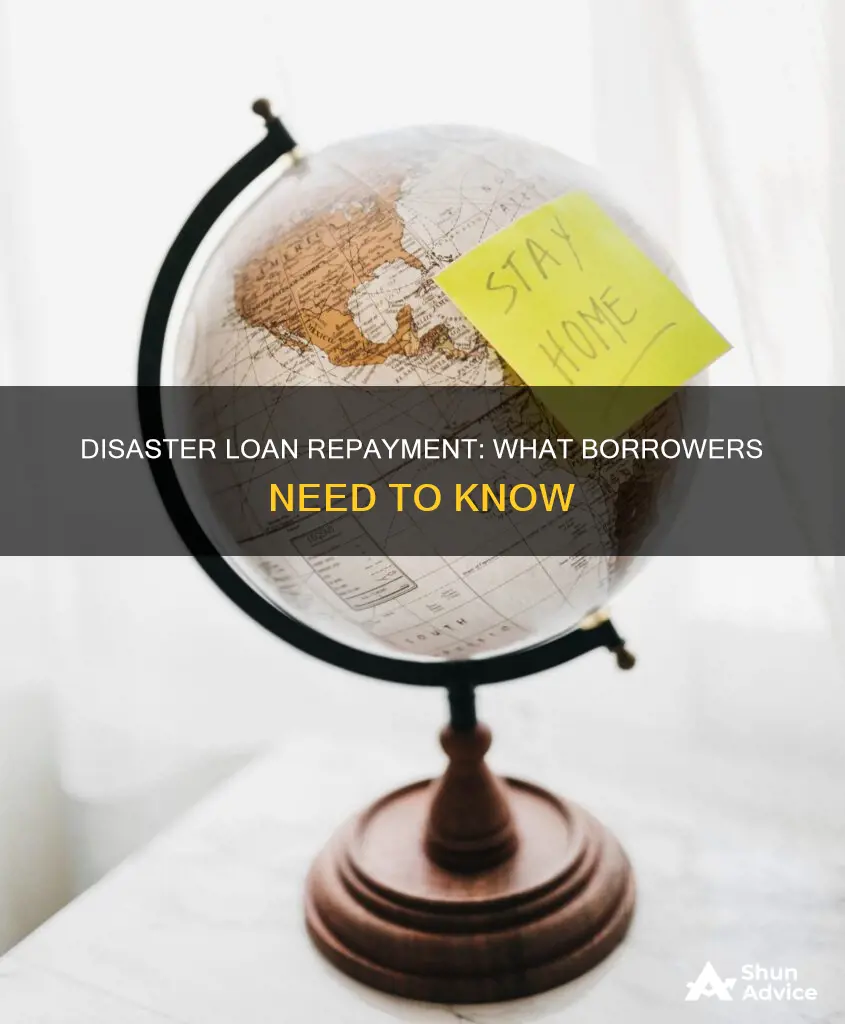
Disaster loans are a crucial source of financial assistance for individuals and businesses affected by natural disasters such as floods, fires, earthquakes, and hurricanes. While FEMA provides grants that do not need to be repaid, disaster loans offered by organizations like the Small Business Administration (SBA) generally must be repaid. SBA disaster loans can provide up to $2 million to businesses, homeowners, and renters, aiding in recovery and rebuilding efforts. However, it's important to note that these loans are not forgivable, and borrowers are expected to make repayments directly to the SBA. Understanding the specifics of disaster loan programs and their repayment requirements is essential for those seeking financial assistance in the aftermath of a calamitous event.
| Characteristics | Values |
|---|---|
| Who can apply for disaster loans? | Small businesses, homeowners, renters, and nonprofits |
| What can disaster loans be used for? | Repair or replace real estate, machinery, equipment, inventory, leasehold improvements, or fixtures |
| What is the maximum amount that can be borrowed? | $2 million for businesses, $500,000 for homeowners, and $100,000 for renters |
| What is the interest rate? | As low as 4% for businesses, 3.625% for nonprofits, and 2.563% for homeowners and renters |
| Do disaster loans have to be repaid? | Yes, except for EIDL Advances or grants |
| What is the repayment period? | Up to 30 years |
| What is the minimum credit score required? | 550 for SBA disaster loans, 580 for EIDL loans from OnDeck |
| Is there a grace period for repayment? | Yes, the SBA offers an interest-free deferral period of 12 months |
What You'll Learn
- Disaster loans are available for businesses, homeowners, and renters
- Disaster loans can be used to repair or replace property
- Disaster loans are not grants and must be repaid
- Disaster loans are not the only form of disaster assistance
- Disaster loans are offered by the Small Business Administration (SBA)

Disaster loans are available for businesses, homeowners, and renters
For homeowners, SBA inspectors will estimate the cost of disaster damage to the property once the application is completed and submitted. SBA can also refinance all or part of a previous mortgage if the applicant has suffered substantial disaster damage and does not have credit available elsewhere. Real estate is the preferred form of collateral for SBA disaster loans, and loans of $200,000 or less do not require the owner to use their primary residence as collateral if other assets are available.
Renters can also apply for SBA disaster loans and do not need to own a business to be eligible. FEMA provides assistance to renters who have lost personal property or been displaced by a disaster. FEMA's National Flood Insurance Program (NFIP) provides flood insurance to renters, and purchasing flood insurance may be required to maintain federal disaster assistance eligibility.
It is important to note that disaster loans, including those from FEMA and SBA, typically must be repaid with interest. However, FEMA grants to disaster survivors do not need to be repaid, and flood insurance from FEMA's NFIP is designed to restore property to its pre-disaster condition without requiring repayment.
Construction Loans: Property Purchase and Development Covered?
You may want to see also

Disaster loans can be used to repair or replace property
Disaster loans are a form of financial assistance offered by the government to aid individuals, businesses, and communities in recovering from a disaster. These loans are typically provided by the Small Business Administration (SBA) and are intended to help repair or replace property damaged or destroyed by a disaster.
The SBA offers two main types of disaster loans: Physical Damage Loans and Economic Injury Disaster Loans (EIDL). Physical Damage Loans can provide funds of up to $2 million to repair or replace buildings, equipment, inventory, machinery, fixtures, and other physical assets. This loan is applicable for businesses, homeowners, and renters. For instance, homeowners can borrow up to $500,000 to fix or replace their primary residences, while renters and homeowners can borrow up to $100,000 to replace personal property.
Economic Injury Disaster Loans, on the other hand, assist with operational costs and day-to-day expenses when sales drop after a disaster. These loans are meant to help businesses stay afloat during challenging times. Similar to Physical Damage Loans, EIDLs also have a limit of $2 million. It is important to note that the total borrowings from these two loan programs are usually capped at $2 million, regardless of whether a business uses one or both programs.
It is worth noting that disaster loans must generally be repaid, often with interest. However, FEMA grants, which do not need to be repaid, may be available in certain circumstances. Additionally, flood insurance, which is mandatory for properties in high-risk flood areas, can provide an alternative source of funding for restoring property to its pre-disaster condition without requiring repayment.
Construction Loans: What's Covered and What's Not?
You may want to see also

Disaster loans are not grants and must be repaid
Disaster loans are a crucial source of financial assistance for individuals and businesses affected by disasters such as floods, fires, earthquakes, and hurricanes. While these loans provide much-needed funds for recovery and rebuilding efforts, it is important to understand that disaster loans are not grants and must be repaid.
The Small Business Administration (SBA) is a key provider of disaster loans, offering assistance to businesses, homeowners, and renters. SBA disaster loans can provide up to $2 million for repairing or replacing real estate, machinery, equipment, and inventory damaged or lost in a disaster. These loans are intended to cover losses not fully covered by insurance and are meant solely for recovery efforts, not for upgrading or expanding a business. The SBA also offers Economic Injury Disaster Loans (EIDLs), which provide up to $2 million to small businesses and nonprofits facing economic challenges due to a disaster.
It is important to note that SBA disaster loans are not forgivable loans. Borrowers are expected to repay the loan amount, along with interest. The SBA offers low-interest rates, and borrowers can repay the loan over a period of up to 30 years, providing flexibility for those rebuilding after a disaster. Additionally, the SBA provides an interest-free deferral period of 12 months before interest starts to accrue.
While disaster loans from the SBA require repayment, it is worth mentioning that there are other forms of disaster assistance that do not need to be repaid. For example, FEMA provides disaster grants that are not considered loans and do not have to be repaid. These grants are designed to help survivors meet their immediate needs, such as emergency supplies, food, and personal hygiene items. FEMA grants also do not affect Social Security benefits, taxes, or other federal assistance programs.
In summary, disaster loans, such as those offered by the SBA, provide essential financial support to those impacted by disasters. However, it is crucial to understand that these loans are not grants and carry the responsibility of repayment. Borrowers should carefully consider the terms and conditions of disaster loans, including interest rates and repayment periods, to ensure they can meet their financial obligations.
Curacao's Loan Services: What You Need to Know
You may want to see also

Disaster loans are not the only form of disaster assistance
The Small Business Administration (SBA) also provides disaster assistance in the form of loans of up to $2 million to businesses that have suffered physical damage or economic losses. These loans can be repaid over as long as 30 years and have low-interest rates, with interest not accruing until a year after the business gets the money. However, applicants need to have adequate credit scores and put up collateral for loans over $25,000.
Additionally, the Internal Revenue Service (IRS) provides tax relief for those affected by federally declared disasters. The IRS works with various agencies, including FEMA, to provide assistance and coordinate disaster relief. They offer resources such as workbooks and tax relief products to help taxpayers compile a list of their losses and prepare and recover from a disaster.
Another option for disaster assistance is flood insurance, which is mandatory for all federal or federally-related financial assistance for the acquisition or construction of buildings in high-risk flood areas. Flood insurance is designed to restore your property to its pre-disaster condition and does not have to be paid back.
Disaster Loan Assistance: Do You Need to Repay?
You may want to see also

Disaster loans are offered by the Small Business Administration (SBA)
Physical damage loans can provide up to $2 million to repair or replace buildings, equipment, or inventory. They are available to businesses, homeowners, and renters in a declared disaster area. The SBA may also boost the $2 million cap in certain cases where substantial jobs are at risk. Homeowners can borrow up to $500,000 to fix or replace their primary residences, while homeowners and renters can borrow up to $100,000 to replace personal property.
Economic injury loans help with day-to-day expenses when sales drop after a disaster and also have a limit of $2 million. These loans are meant to cover expenses such as working capital and other normal operating costs. A business can apply for both physical damage and economic injury loans, but the total borrowing amount is usually capped at $2 million.
The SBA disaster loans are direct loans, not loan guarantees, meaning applicants don't need approval from a local bank. However, they must have adequate credit scores and collateral for loans over $25,000. Interest rates for these loans are competitive, with rates as low as 4% for businesses, 3.625% for nonprofits, and 2.563% for homeowners and renters. Interest does not start to accrue until a year after the funds are received, and the loans can be repaid over as long as 30 years.
It is important to note that SBA disaster loans must be repaid over time, and applicants are not obligated to accept the loan if approved. The SBA works in partnership with FEMA to provide disaster assistance, and applying for an SBA loan may open the door to additional grants or assistance from FEMA if the SBA loan is not accepted or only partially offered.
Loans, Advances, and Current Assets: What's the Verdict?
You may want to see also
Frequently asked questions
Yes, disaster loans generally have to be repaid. However, there are some exceptions, such as the EIDL Advance during the pandemic, which did not need to be repaid.
EIDL stands for Economic Injury Disaster Loan. It is a government-backed loan that provides low-interest, long-term disaster relief financing to small businesses and nonprofits that have been adversely impacted by a declared disaster.
SBA Disaster Loans are a good example. These loans are provided by the Small Business Administration and must be repaid. They are low-interest loans to help businesses, homeowners, and renters recover from natural disasters.
The repayment process can vary depending on the loan provider. For SBA Disaster Loans, borrowers can make payments through phone, online, or mail. It is important to review the loan documents for specific instructions and contact the loan provider for clarification if needed.







